It was a good day of ephemera at one of my favorite auction houses this week. Not a lot of it, but enough to enough to get me excited.

The house had it grouped together in at least two glass cases – one with about eight to 10 trays of ephemera, the other with about five. The tray that intrigued me had linen and photo postcards of several New York hotels, comical postcards of an Army private and a “Things to do in Atlantic City” guide for the week of May 26, 1951.
The one item in the lot that I just had to have was this book:
“Little Leather Breeches and other Southern Rhymes”
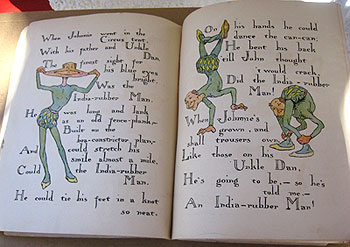
It was a children’s book (9 ¼” x 11 ¾”) with construction-paper pages and type that looked like it had been done on a typewriter with oversized keys. It was tattered around the edges, a little dirty and soiled. No front and back cover, the staples on the spine exposed.
There were 24 pages, including the front inside page, but there were no numbers on the pages. I found a complete copy on the web and saw that the actual book had 48 pages, so this one was missing half its pages. It was a First Edition with issues.
The book – as noted on the inside cover – contained “Folk-lore songs, Negro rhymes, Street-venders’ cries, etc., gathered from various parts of the South.” These had been collected and illustrated by a man named Francis P. Wightman, and published by J.F. Taylor and Company in 1899.
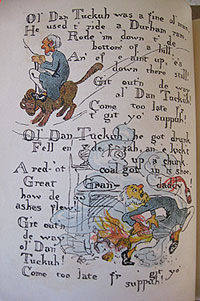 The stories included a tale about a squirrel and other animals, a sailor boy who went to sea, a little maid (baby) with blue eyes, old Dan Tuckuh who rode a ram, got drunk and fell in the fire, and an Indian rubber man at the circus who could do contortions.
The stories included a tale about a squirrel and other animals, a sailor boy who went to sea, a little maid (baby) with blue eyes, old Dan Tuckuh who rode a ram, got drunk and fell in the fire, and an Indian rubber man at the circus who could do contortions.
Here’s the first rhyme from the book:
“Oh! My little boy, who made your breeches?
Mammy cut ‘em out,
Daddy sewed th’ stitches.
Leather breeches, full o’ stitches;
Leather breeches, buttons on!
Mammy pulled me out o’ baid
Becuz I had my breeches on!
Here I stand, on two little chips,
Do come kiss my ruby little lips.”
It was an interesting find for me the Southerner. I knew, too, that if there were illustrations of black people in the book, they’d be distortions. Us as stereotypes, not as individuals.
So, guess what I came across on page 3: a rotund black woman selling fish, with a kerchief on her head and her lips colored red. Other black people were depicted the same. Although the characters in the book were whimsically drawn, none of the others represented a type. Even the animals – the squirrel, the horse, the cow, the frog – were drawn in their natural states.
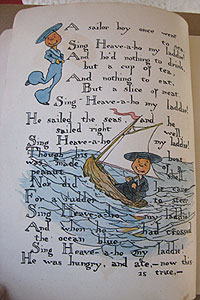 The stories were written mostly in dialect – clipped words, strange utterances (well, at least to non-Southerners), vernacular spellings – and a few were in “proper” English. Southerners speaking as southerners in their own language.
The stories were written mostly in dialect – clipped words, strange utterances (well, at least to non-Southerners), vernacular spellings – and a few were in “proper” English. Southerners speaking as southerners in their own language.
At the end of some of the rhymes and songs, Wightman had listed the state they came from: North Carolina; St. John’s River, Fla.; Roanoke, Va.; Charleston, S.C.
The illustrations, on the whole, were quite nicely done. In my research, I could find out very little about Wightman himself, but did come across other books that he illustrated around the turn of the 20th century. Several were in the style of “Little Breeches.”
One book called “Mammy ‘mongst the wild nations of Europe,” written in dialect in 1904 by historian Ruthella Mory Bibbins, told the story of a black woman who took a trip to the coronation of King Edward VII with her young charges.
A website selling the book (for $350) described it this way: “Without a doubt, one of the most superb examples of early 20th century American racist stereotyping we’ve encountered. … A hilarious if not terribly offensive portrait of American cultural sensibilities and sensitivities at the dawn of the 20th century.”
Another site ($285) called it “more paternal than racist.” The Charles L. Blockson Afro American Collection at Temple University in Philadelphia has an original copy of the book.
Another of Wightman’s illustrated books, written about the same time as “Little Breeches” and in the same tone, was called “Jingle jangle jumbly,” part of a longer title. Here are others of his books on amazon.com.
Wightman illustrated non-plantation-related books, including one written anonymously in 1908 by L. Frank Baum called “The Last Egyptian: A Romance of the Nile.” Baum had written the beloved “The Wonderful World of Oz” in 1900 and was afraid that writing a novel would hurt his image as a children’s books writer, according to wikipedia.
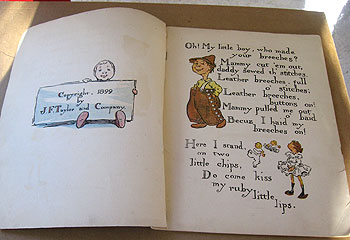
Wightman also participated in illustrating “Teddy-B and Teddy-G The Bear Detectives” by Seymour Eaton (1909).
When “Little Breeches” was sold in 1900, it could be had for $1.50. Today, on several book dealers’ websites, it was going for $230 to $495. Others of Wightman’s books were being offered for even more (“Bear Detectives” at $2,600).
Mine, though, with all its missing pieces, probably isn’t worth much at all. Except for its historical value of capturing Southern folklore, which come to think of it does make it worthy despite its issues.
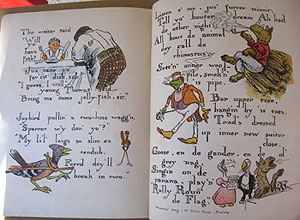

I have one copy of a complete bound book comprised of 22 pages with illustrated front cover and back
cover given to my father in law for xmas 1903.
That’s great, Thomas, that you have a book that has remained in the family. Hopefully, I’ll eventually come across a complete book.
Sherry